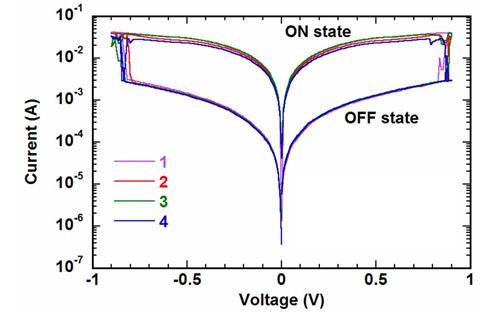Resistive RAM (RRAM or ReRAM) is a non-volatile random access memory which uses the variation of the resistance value across a dielectric solid-state material to achieve its functions. The two binary states are stored in a metal/insulator/metal (MIM) structure which offers two distinct states of resistance.
The resistive switching can be controlled by a voltage or a current. So the resistive structure can switch from a low resistance state (ON state) to a high resistance state (OFF state).
ReRAMs can be classified according to the nature of the material, and also by the commutation mechanism. These can be regrouped into the following categories:OxRRAM (Oxide Resistive RAM): the commutation mechanism is based on thermic effects, and presents a unipolar characteristic (It does not depend on the sign of the applied voltage or current).
Nanoionic memories: based on a MIM structure formed by a passive electrode (W,Pt…), a ionic conductor (WO3, GeSe…) and an active electrode (Ag, Cu…) which can create diffusing ions by electrochemical reaction. The commutation present a bipolar characteristic.
Macromolecular memories: also called polymer or organic memories, based on the integration of metallic elements into a thin film of organic material. These metallic elements can be thin films, nanoparticles or metallic ions in an organometallic material.
ReRAM present a strong potential by their capacity to support miniaturization and their performances: commutation time less than 10ns and programming time less than 2V. However ReRAM are not mature enough to be marketed.
 |
 |
 |
December 17-19, 2015 at Amiens (France)







